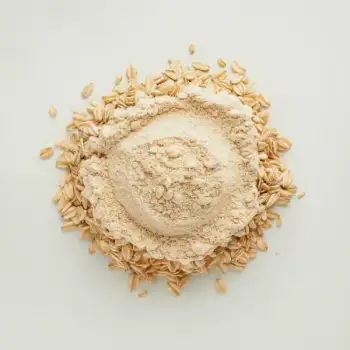All Purpose Flour and Oat Flour are two distinct flours used in cooking and baking, with differences in gluten content, texture, and flavor, suitable for various recipes and dietary needs.

All Purpose Flour, often known as AP flour, is a versatile wheat flour that is milled to create a fine texture suitable for a wide range of baking and cooking applications. It's a staple in many kitchens due to its adaptability.

Oat Flour is made by grinding whole oat groats or steel-cut oats into a fine powder. It's a gluten-free alternative to traditional wheat flours and offers a distinctively nutty flavor, making it a favorite for health-conscious bakers.
The primary differences lie in their source, with AP flour coming from wheat and oat flour from oats. All Purpose Flour has a neutral taste and is gluten-rich, providing structure to baked goods, while Oat Flour offers a sweeter, nutty flavor and is gluten-free, which can result in a denser texture.

Your ultimate Recipe Box, Meal Planner, and Cooking Class all in one
Ideal for cakes, cookies, and breads, All Purpose Flour provides a classic structure and crumb. Expect a light and airy texture, especially when properly aerated and mixed. Tips: Sift the flour before use to prevent clumping and measure accurately for consistent results. Best for pancakes, muffins, and quick breads, Oat Flour adds a wholesome, hearty flavor. Expect denser outcomes due to its lack of gluten. Tips: Increase baking powder to help with the rise and consider blending with other flours for better texture.
Commonly used to thicken sauces, gravies, and soups. It creates a smooth consistency and is relatively flavor-neutral. Tips: Make a roux with equal parts flour and fat to start your sauce, cooking it for a few minutes to eliminate the raw flour taste. While less common, Oat Flour can also thicken dishes, adding a slight nutty taste. It's perfect for gluten-free requirements. Tips: Whisk it into your liquids gradually to avoid clumping and start with less, as its thicker texture may require adjustment.
A go-to for creating a crispy coating on fried foods and for dusting surfaces for dough preparation. Tips: Season your flour well for added flavor and ensure a thin, even coat for the crispiest results. A gluten-free option for breading, it provides a unique texture and taste. Tips: Oat Flour may brown more quickly, so adjust cooking times and temperatures accordingly.
Oat Flour is higher in fiber and is a gluten-free alternative, offering nutritional benefits for those with specific dietary needs.
| Nutrient | Oat Flour ( per 100 grams ) | All Purpose Flour ( per 100 grams ) |
|---|---|---|
| Fat | 9.12g | 0.98g |
| Fiber | 6.5g | 2.7g |
| Sodium | 2mg | 2mg |
| Protein | 14.66g | 10.33g |
| Calories | 404 | 364 |
| Carbohydrates | 65.7g | 76.31g |
While you can substitute Oat Flour for All Purpose Flour, it's not suitable for all recipes due to its lack of gluten, which affects texture. It works best in recipes like pancakes and quick breads.
Yes, Oat Flour has a nutty taste that can enhance the flavor profile of your recipes, especially baked goods.
Oat Flour generally has more fiber and protein compared to All Purpose Flour, and it's gluten-free, making it a healthier option for those with gluten sensitivities.
Yes, adjustments may be needed, such as increasing the amount of leavening agents or adding binding substitutes like xanthan gum to compensate for the lack of gluten.
Oat Flour can be used as a coating for frying, but it may result in a different texture and taste compared to All Purpose Flour, and it tends to brown more quickly.